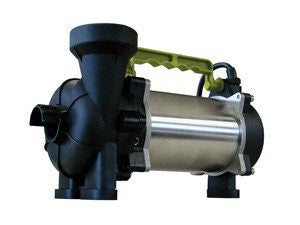
Recently made pond pumps are extremely reliable and energy-efficient, and getting more and more so every few years. As with any mechanical device, though, there are things that can go wrong. Fortunately, problems with pond pumps are fairly predictable, and checking on just a few things can solve the majority of pump failures. I’ve put together a quick checklist of things to try before contacting the manufacturer. Feel free to ignore this list if you’re just looking for an excuse to get a new pump.
- Check water flow to the pump. This is, far and away, the most common pump problem that I’ve seen from customers. Your pump can’t push water if it doesn’t have access to it. First, check to see if there is anything keeping water from getting to the pump, be it a large rock or debris, leaves, a clogged skimmer net or opening, a jammed skimmer flap, or just a skimmer mat that has gone too long between cleanings. All of these things can keep water away from the intake on your pump. Your pond could also just have low water, keeping the pump from getting enough water through the skimmer box. Keep in mind that, between the plumbing, your filter/waterfall box, and the waterfall itself, the pump will drop the water level a good bit when it’s running. It may seem like the skimmer box is plenty full when the pump is disconnected, but once it starts it the box runs dry or nearly dry.
- Make sure the pump isn’t vapor locked. A vapor lock happens when the pump gets an air bubble trapped in the volute, the main internal space of the pump. The impeller will spin, but it won’t be able to move water because of that air bubble. The solution to this one is pretty simple, just tilt the pump underwater so that the intake is upward, letting the air bubble escape.
- Make sure the pump is getting electricity. Check the ground fault and circuit breaker to make sure that neither has been tripped. You may also want to try plugging a different compatible appliance into the outlet your pump usually uses to make sure that power is getting to the outlet. If not, it’s time to call in a qualified electrician.
-
Flush your plumbing. The easiest way to do this is to disconnect the fitting above the check valve, letting water flow out of the system and back into the skimmer box, bringing any possible clogs with it.

- Pull your pump out to inspect it. Check the intake on your pump for any debris that has lodged in it. Most pumps will deal with small debris pretty well, but something like a rock or large piece of detritus could get in there and block the impeller or intake. Clean out the intake to make sure that it’s clear.
- Try it again. After you’ve got the pump out and cleaned, try plugging it in at this point to see if the impeller is spinning. If it isn’t spinning, go to the next item. If it is spinning at this point, re-install and try it again. If your impeller is spinning properly at this point and you’re still not getting water flow, then it’s time to check again to make sure that your pump is getting enough water and that your plumbing is clear.
- Jumpstart your pump. If your impeller isn’t spinning, first try a jumpstart. Unplug the pump and carefully give the impeller an assisted bump with a screwdriver. If the impeller has seized up, this should knock it loose and give it a chance to spin freely. Plug it back in and, if the impeller is now spinning, unplug it again and re-install it.
- Check the power supply. If the impeller is able to move freely but still isn’t spinning when plugged in, take it to a different electrical outlet to try it. This must be an outlet with a ground fault (GFCI). Plug in the pump at this different outlet. If the pump still doesn’t respond or if the pump trips the ground fault, something is likely wrong with the pump. If the pump works fine at another outlet, then something is wrong with the electrical supply at your pond, and it’s again time for an electrician.
Once you’ve run through these items with no joy, it’s time to get in touch with the pumps manufacturer. Seriously, though, it’s probably just the pump not getting enough water.


